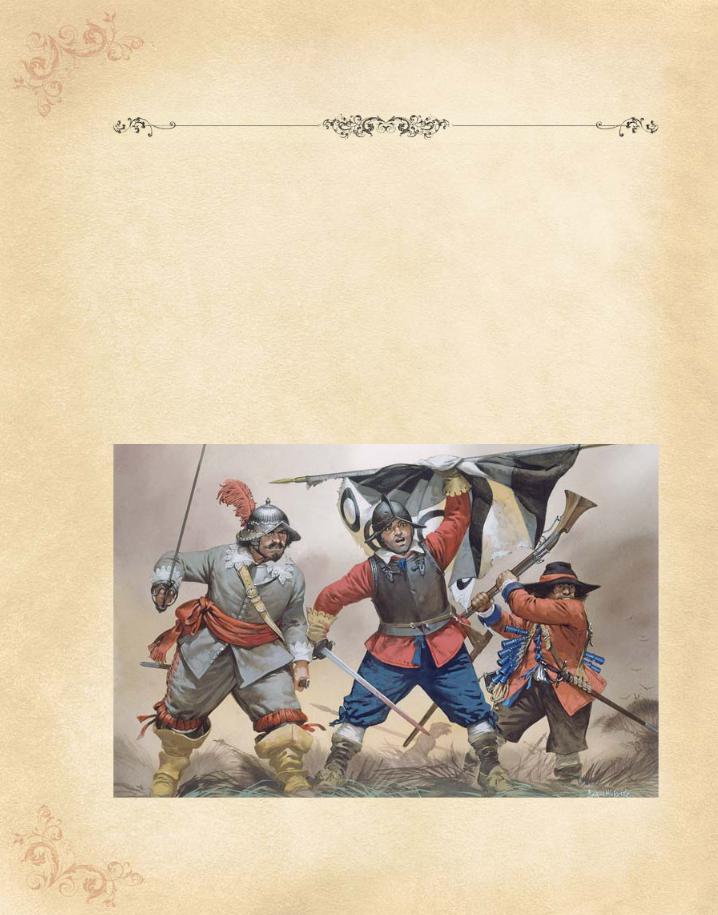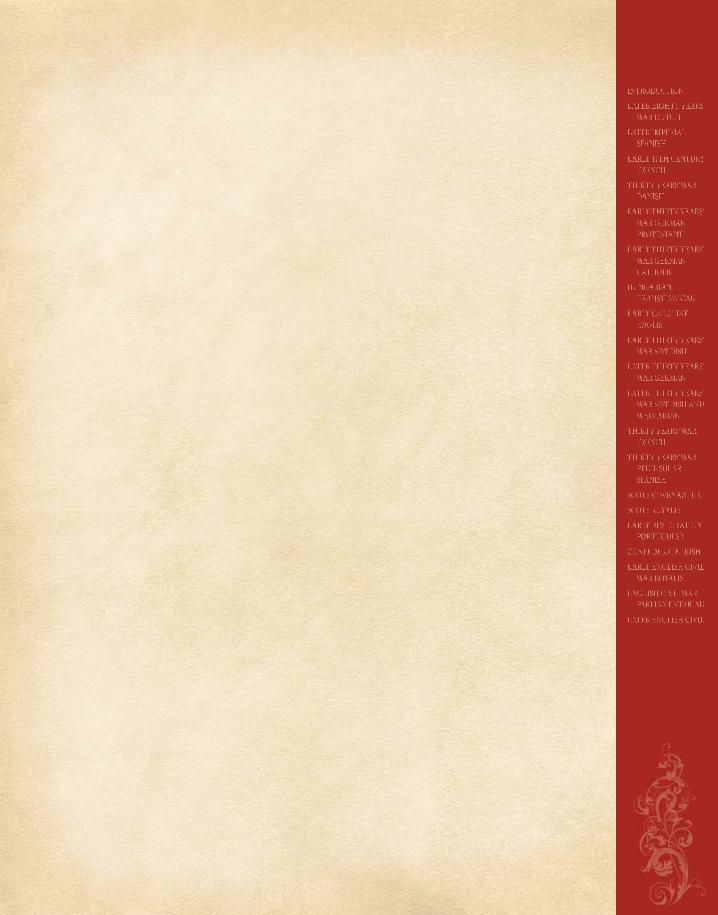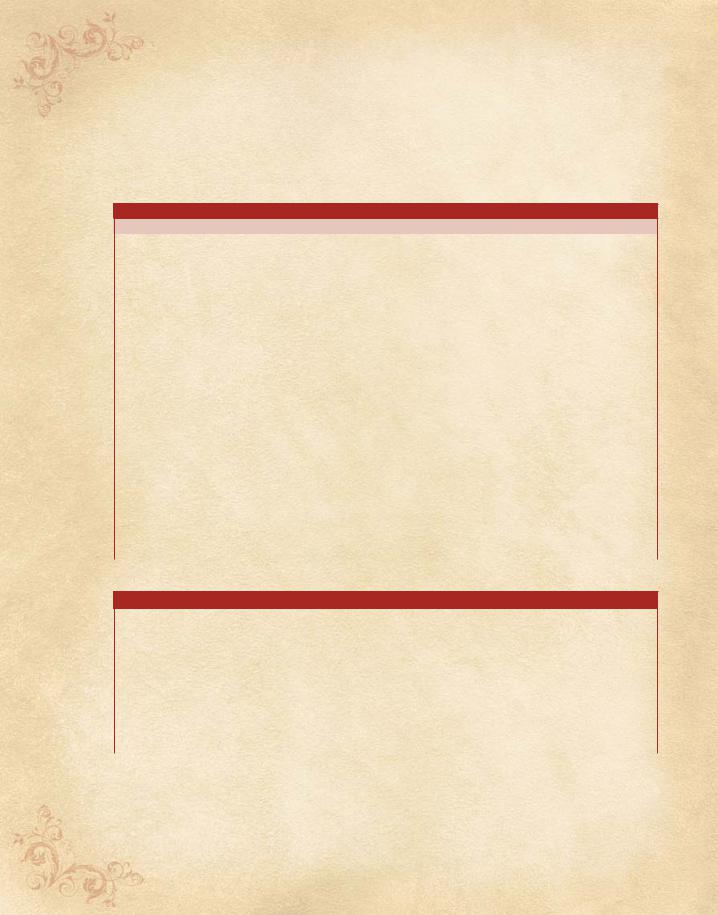
- •INTRODUCTION
- •LATER EIGHTY YEARS’ WAR DUTCH
- •LATER IMPERIAL SPANISH
- •EARLY 17TH CENTURY FRENCH
- •THIRTY YEARS’ WAR DANISH
- •EARLY THIRTY YEARS’ WAR GERMAN PROTESTANT
- •HUNGARIAN-TRANSYLVANIAN
- •EARLY CAROLINE ENGLISH
- •EARLY THIRTY YEARS’ WAR SWEDISH
- •LATER THIRTY YEARS’ WAR GERMAN
- •LATER THIRTY YEARS’ WAR SWEDISH AND WEIMARIAN
- •THIRTY YEARS’ WAR FRENCH
- •THIRTY YEARS’ WAR PENINSULAR SPANISH
- •SCOTS COVENANTER
- •SCOTS ROYALIST
- •EARLY RESTORATION PORTUGUESE
- •CONFEDERATE IRISH
- •EARLY ENGLISH CIVIL WAR ROYALIST
- •ENGLISH CIVIL WAR PARLIAMENTARIAN
- •LATER ENGLISH CIVIL WAR ROYALIST
- •NEW MODEL ARMY
- •EARLY LOUIS XIV FRENCH
- •APPENDIX 1 – USING THE LISTS
- •INDEX

WARS OF RELIGION
NEW MODEL ARMY
By the end of 1644, prompted by the failure of their combined armies to defeat the King at the Second Battle of Newbury,
Parliament decided that a radical overhaul of their forces was needed to force a decision in what was becoming a drawn out war. The result of this was a “new modelling” of the main field army of Parliament, drawing on the best of the soldiers from the armies of Essex, Waller and the Eastern Association to form a hopefully war-winning force. This was accompanied by the Self Denying Ordinance, whereby members of Parliament, of both the House of Commons and the House of Lords, debarred themselves from military command in order to remove politics from
military command – although Oliver Cromwell was given a dispensation from this as Sir Thomas Fairfax requested he be allowed to fill the role of Lieutenant-General of the Cavalry. Thus the “New Model Army” was created. The planned strength of the army was to be 11 regiments of horse, each of 600 troopers, 12 regiments of foot, each of 1,200 men, and a single regiment of dragoons of 1,000 men. Additionally, an artillery train would be provided. Those soldiers not incorporated into the new army would remain in subsidiary regional forces.
Despite being able to draw on three existing armies for its recruits, the army was still rather under strength when it took the field in 1645.
The New Model Army, 1645, by Angus McBride © Osprey Publishing Ltd. Taken from Elite 25:
Soldiers of the English Civil War (1): Infantry.
98
© Osprey Publishing ¥ www.ospreypublishing.com

NEW MODEL ARMY
Cavalry numbers were easily reached, but the infantry numbers were very low. Despite a ruthless impressment campaign, they were still below establishment at the Battle of Naseby – at which, nevertheless, the New Model Army was victorious, finally destroying any chance the King had of winning the war.
Following the end of the First Civil War, Parliament chose to retain a standing army, the first significant standing force ever maintained by England. Following the end of the war, however, the army became radicalised by Protestant nonconformists and started to intervene in politics. This significantly affected the English view of standing armies, and her politicians remained suspicious of such standing forces thereafter.
Subsequently the army fought in Ireland (1649–1652), in Scotland (1650), England (against invading Scots in 1651 and various Royalist uprisings) and, strangely, in support of Catholic France (1654) against Spain. English infantry and naval gunfire were important in Turenne’s victory at the Battle of the Dunes. An army was also sent to the West Indies in 1654 as part of the war against Spain.
Ironically, after playing such a major part in the defeat and overthrow of Charles I, the army was then instrumental, under General George Monck,
in restoring his son to the throne as Charles II. Following the restoration, most of the army was disbanded.
The first Lord-General of the New Model was Sir Thomas Fairfax, with Oliver Cromwell as Lieutenant-General of the Cavalry and Philip Skippon as Sergeant-Major General of the Foot. Cromwell later took over as Lord-General in 1649 when Sir Thomas declined the command of the army to campaign in Ireland.
This list covers the English army of Parliament from the creation of the “New Model Army” in 1645, through the army of the English Commonwealth, until most of the standing army was demobilised following the restoration of King Charles II in 1660. The army sent to the West Indies in 1654 is covered by a later list in Field of Glory Renaissance Companion 6: Cities of Gold.
TROOP NOTES
Despite being partly drawn from existing armies, the quality of the New Model infantry was not high. This appears to be because many of the soldiers were in fact impressed Royalists and rounded-up deserters. The cavalry, on the other hand, was a quality force based around the formidable Eastern Association troops.
|
|
|
|
|
|
|
|
|
|
|
|
|
NEW MODEL ARMY STARTER ARMY |
|
NEW MODEL ARMY |
||||||
Commander-in-Chief |
|
1 |
|
Field Commander |
|
|
|
|
|
|
|
|
|
|
|
|
|||||
Sub-Commanders |
|
2 |
|
2 x Troop Commander |
|
|
|
|
|
|
|
|
|
|
|
|
|
|
|
|
|
Horse |
|
2 BGs |
Each comprising 4 bases of horse: Superior, Armoured, Determined Horse – |
|
|
|
|
|
|
|
|
|
|
|
|
|
|||||
|
|
|
|
|
|
|||||
|
Impact Pistol, Melee Pistol |
|
|
|
|
|
|
|||
|
|
|
|
|
|
|
|
|
|
|
Horse |
|
2 BGs |
Each comprising 4 bases of horse: Average, Armoured, Determined Horse – |
|
|
|
|
|
|
|
|
Impact Pistol, Melee Pistol |
|
|
|
|
|
|
|||
|
|
|
|
|
|
|
|
|
|
|
Foot |
|
3 BGs |
Each comprising 6 bases of foot: 2 Average, Unarmoured, Heavy Foot – Pike; |
|
|
|
|
|
|
|
|
and 4 Average, Unarmoured, Medium Foot – Musket |
|
|
|
|
|
|
|||
|
|
|
|
|
|
|
|
|
|
|
Dragoons |
|
1 |
BG |
3 bases of dragoons: Average, Unarmoured, Dragoons – Musket |
|
|
|
|
|
|
Field artillery |
|
1 |
BG |
2 bases of field artillery: Average, Medium Artillery – Medium Artillery |
|
|
|
|
|
|
Camp |
|
1 |
|
Unfortified camp |
|
|
|
|
|
|
Total |
|
9 |
BGs |
Camp, 16 mounted bases, 23 foot bases, 3 commanders |
|
|
|
|
|
|
99
© Osprey Publishing ¥ www.ospreypublishing.com

WARS OF RELIGION
BUILDING A CUSTOMISED LIST |
• Commanders should be depicted as Horse. |
USING OUR ARMY POINTS |
|
Choose an army based on the maxima and |
|
minima in the list below. The following special |
|
instructions apply to this army: |
|
NEW MODEL ARMY
Territory Types: Agricultural, Hilly, Woodlands
C-in-C |
|
Great Commander/Field Commander/Troop Commander |
80/50/35 |
|
1 |
|
|||||||||
Sub-commanders |
|
|
Field Commander |
|
|
|
50 |
|
|
0–2 |
|||||
|
|
Troop Commander |
|
|
|
35 |
|
|
0–3 |
||||||
|
|
|
|
|
|
|
|
|
|||||||
Troop name |
|
|
Troop Type |
|
Capabilities |
|
Points |
Bases |
Total |
||||||
|
Type |
|
Armour |
Quality |
Shooting |
Impact |
|
Melee |
per base |
per BG |
bases |
||||
|
|
|
|
||||||||||||
|
|
|
|
Core Troops |
|
|
|
|
|
|
|
|
|
|
|
Horse |
|
Determined |
|
Armoured |
Superior |
– |
Pistol |
|
Pistol |
21 |
|
4 |
8–32 |
||
|
horse |
|
Average |
|
15 |
|
|||||||||
|
|
|
|
|
|
|
|
|
|
|
|
|
|||
Foot |
|
Medium Foot |
Unarmoured |
Average |
Musket |
– |
|
– |
8 |
4 |
|
6 |
12– |
|
|
|
Heavy Foot |
|
Unarmoured |
Average |
– |
Pike |
|
Pike |
5 |
2 |
|
64 |
12– |
||
Veteran Foot |
Only from |
Medium Foot |
Unarmoured |
Superior |
Musket |
– |
|
– |
11 |
4 |
|
6 |
0– |
72 |
|
1646 |
Heavy Foot |
|
Unarmoured |
Superior |
– |
Pike |
|
Pike |
8 |
2 |
|
18 |
|
||
|
|
|
|
|
|
||||||||||
Field artillery |
|
Medium |
|
– |
Average |
Medium |
– |
|
– |
20 |
|
2 |
0–2 |
|
|
|
|
Artillery |
|
|
|
Artillery |
|
|
|
|
|
|
|
|
0–4 |
Light artillery |
|
Light |
|
– |
Average |
Light |
– |
|
– |
12 |
|
2 |
0–2 |
||
|
|
|
|
|
|||||||||||
|
Artillery |
|
Artillery |
|
|
|
|||||||||
|
|
|
|
Optional Troops |
|
|
|
|
|
|
|
|
|
||
Dragoons |
|
Dragoons |
|
Unarmoured |
Average |
Musket |
– |
|
– |
8 |
3 or 4 |
0–6 |
|||
Firelocks |
|
Medium Foot |
Unarmoured |
Average |
Musket |
– |
|
– |
7 |
|
4 |
0–4 |
|||
Association or militia horse |
Determined |
|
Armoured |
Average |
– |
Pistol |
|
Pistol |
15 |
|
4 |
0–8 |
|||
horse |
|
Poor |
|
11 |
|
||||||||||
|
|
|
|
|
|
|
|
|
|
|
|
|
|||
Association or militia foot |
Medium Foot |
Unarmoured |
Poor |
Musket |
– |
|
– |
6 |
4 |
|
6 |
0–18 |
|||
Heavy Foot |
|
Unarmoured |
Poor |
– |
Pike |
|
Pike |
3 |
2 |
|
|||||
|
|
|
|
|
|
|
|
||||||||
NEW MODEL ARMY ALLIES
Allied commander |
|
Field Commander/Troop Commander |
|
40/25 |
|
|
|
1 |
|
|||||
Troop name |
|
|
Troop Type |
|
Capabilities |
Points |
Bases |
|
Total |
|||||
|
Type |
Armour |
Quality |
Shooting |
Impact |
Melee |
per base |
per BG |
bases |
|||||
|
|
|||||||||||||
Horse |
|
Determined |
Armoured |
Superior |
– |
Pistol |
Pistol |
21 |
|
4 |
|
4–12 |
||
|
Horse |
Average |
15 |
|
|
|||||||||
|
|
|
|
|
|
|
|
|
|
|
|
|||
Foot |
|
Medium Foot |
Unarmoured |
Average |
Musket |
– |
– |
8 |
4 |
|
6 |
|
6– |
|
|
Heavy Foot |
Unarmoured |
Average |
– |
Pike |
Pike |
5 |
2 |
|
|
24 |
6– |
||
Veteran Foot |
Only from |
Medium Foot |
Unarmoured |
Superior |
Musket |
– |
– |
11 |
4 |
|
6 |
|
0–6 |
24 |
1646 |
Heavy Foot |
Unarmoured |
Superior |
– |
Pike |
Pike |
8 |
2 |
|
|
|
|||
|
|
|
|
|
|
|||||||||
100
© Osprey Publishing ¥ www.ospreypublishing.com

NEW MODEL ARMY
NEW MODEL ARMY
Cavalry of the New Model Army, 1645, by Angus McBride © Osprey Publishing Ltd. Taken from Elite 27:
Soldiers of the English Civil War (2): Cavalry.
101
© Osprey Publishing ¥ www.ospreypublishing.com
